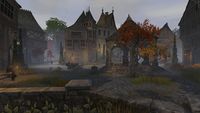| This page or section is incomplete. You can help by adding to it. Needs new ESO Gold Road info For more information, see the help files, the style guide, and this article's talk page. |
| Sutch | |
|---|---|
| Type | Settlement |
| Continent | Tamriel |
| Province | Cyrodiil |
| Region | Gold Coast |
| Appears in | Oblivion, ESO |

Sutch was a major Colovian city located in the Gold Coast region of Cyrodiil, near the edges of the Colovian Highlands and the border with Hammerfell.[1] From the First Era to the end of the Third Era, Sutch was a notable cultural hub noted for its artists, artisans, and performers that attracted visitors seeking artistic and philosophical pursuits.[2] County Sutch extended north towards the Brena River, an area which is now considered part of County Kvatch. Sutch was connected to the Gold Road north of Anvil.[3][UOL 1] There was a once Blood Dome Temple found within the city.[UOL 2]
HistoryEdit
Long before the Planemeld, Sutch was home to the wealthy Baron Ignace, whose castle was noted for its tall and unscalable walls. The book Thief of Virtue tells the tale of Ravius Terinus, a master thief of the Thieves Guild, who attempted to rob the coin collection of Baron Ignace from the latter's castle in Sutch. Ravius failed to steal the coins, but instead slept with Baroness Veronique in order to hide from the guards. The book states that Sutch was a city in Hammerfell; it is unknown if this is an error or if Sutch was once indeed considered part of nearby Hammerfell. The author also believes the Thieves Guild to have been wiped out 450 years prior to the book's writing,[4] but as various branches of "thieves' guilds" have always existed and the book's publication date is unknown, it is unclear which guild this was referring to.[5]
By the Interregnum, Sutch had become a large city and trade center.[6] Jorunn the Skald-King visited Sutch in his youth, sometime between 2E 546 and 2E 572, for its artistic values.[2] Phrastus of Elinhir visited the marketplace of the city around the time of the Planemeld and met a hunter who had trapped a river troll,[6] and two towers near Sutch could be seen behind Varen's Wall around 2E 582.[7]
In 2E 582, a gang of vampires led by Balandrus, the Terror of the Weald, attacked the city. Even though Balandrus was killed, the population of Sutch was decimated during this event.[8]
Sea shanties from Sutch were popular among sailors around the time of the Tiber War.[UOL 3]
The city was still marked on maps in 2E 864[1] and 3E 427. By 3E 433, nothing remained of the settlement but the ruins of Fort Sutch Abbey. The fort was home to a band of mercenaries until their ailing warlord, Roderick, was poisoned by the Dark Brotherhood, although it was made to appear that he had died from his illness.[9] The fort was attacked by Daedra during the Oblivion Crisis when an Oblivion Gate to the Deadlands opened outside its walls. The Gate was destroyed by the Imperial Legion, with the help of the Hero of Kvatch.[10]
GalleryEdit
-
The ruins of Fort Sutch ca. 3E 433 (Oblivion)
-
Two towers near Sutch ca. 2E 582 (ESO)
-
Imperial Legion Soldiers defending Fort Sutch ca. 3E 433 (Oblivion)
-
The local wayshrine
-
A map of Cyrodiil locating Sutch ca. 2E 582 (ESO)
-
A map of Cyrodiil locating Sutch in the Colovian West ca. 3E 427
-
Roderick, warlord of Fort Sutch, on his deathbed ca. 3E 433 (Oblivion)
NotesEdit
- The author Charonius of Sutch presumably hailed from Sutch, sometime before 2E 582.[11] Thendaramur Death-Blossom, Boethiah's Conduit who oversaw dozens of Gauntlets, also came from the city.[12]
- The city of Sutch was originally set to appear in Oblivion but was removed before release, as can be seen in the terrain surrounding Fort Sutch, which is unusually flat and sparse compared to the rest of the Gold Coast. As such, a few references to the city as still existing were mistakenly left in the final game.[UOL 1]
See AlsoEdit
- For game-specific information, see the Oblivion and Elder Scrolls Online articles.
ReferencesEdit
- ^ a b Map of West Tamriel
- ^ a b Jorunn the Skald-King — Helgreir Lute-Voice, Bard of Windhelm
- ^ Pinarus Inventius' dialogue in Oblivion
- ^ Thief of Virtue
- ^ Members of the Hew's Bane Thieves Guild Answer Your Questions — Walks-Softly, Kari Coin-Counter, Velsa, Zeira, Thrag, Andarri
- ^ a b Field Guide to River Trolls — Phrastus of Elinhir
- ^ Events of ESO: Dark Brotherhood
- ^ Events of Terror of the Weald in ESO: Gold Road
- ^ Bad Medicine quest in Oblivion
- ^ Attack on Fort Sutch quest in Oblivion
- ^ Thibaut's Cairn and its History — Charonius of Sutch
- ^ The Rite of Boethiah's Gauntlet — Thendaramur Death-Blossom, Boethiah's Conduit of Sutch
Note: The following references are considered to be unofficial sources. They are included to round off this article and may not be authoritative or conclusive.